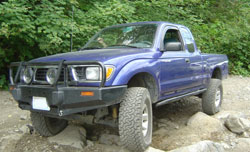When it comes to trucks, or pretty much any vehicle, the front end is very susceptible to serious damage if involved in a collision. Vehicle manufacturers do their best to continuously upgrade vehicle frames to prevent such damage but it is sometimes not enough.
Enter the bull bar.
Bull bars are an accessory typically installed aftermarket to provide truck owners an added sense of security for their trucks and themselves. However, due to its positioning on the truck, owners wonder if bull bars will obstruct any truck functions such as pre-existing parking sensors.
Yes, bull bars will interfere with parking sensors because they are normally installed in front of them. The only way to avoid this from happening is to purchase a parking-sensor friendly bull bar.

How do bull bars interfere with parking sensors?
If you put a blindfold on a bat? What do think will happen to its sight?
Trick question!
Bats “see” via echolocation. They emit ultrasonic chirps from their mouths, whose waves bounce off their prey and other objects. The waves return to their ears and they analyze them accordingly to determine what is and isn’t food.
That is generally how the parking sensors on your trucks work.
What exactly is a parking sensor?
To know why bull bars would affect parking sensors, we should first understand the working of a parking sensor.
It is a device that is used to alert the driver of obstacles or objects within close proximity of the vehicle.
In other words, a parking sensor is a proximity sensor.
As mentioned earlier, a parking sensor works under the same principle as echolocation used by bats when locating food. A bat sends out a high pitch sound and when these sound waves reflect off of prey or obstacles, it can discern the general location of the food or avoid a large obstacle.
Similarly, parking sensors are of two kinds, one which uses ultrasonic sound while another uses electromagnetic waves.
Ultrasonic
Ultrasonic sensors emit a high-frequency sound wave that reflects off of surfaces around the car. The sensor then receives these reflected sound waves and calculates the distance from the vehicle and warns the driver with a beeping noise.
Electromagnetic
Electromagnetic sensors, too, work in the same way. It uses electromagnetic frequencies which detect a wider range of wavelengths and can deduce more objects in the way of the car or surrounding it.
It can pick up more information than sound waves since sound waves can be obstructed.
Parking sensors are also paired with front and back-facing cameras to know the exact position of the car at any given moment.
Bull bars, being located at the front bumper, may deter the emissions of these waves by providing an obstruction. Thus, causing a relay of false information to the system about an obstruction that is actually the bull bar itself.
Signs of interference
The major sign of interference to the parking sensor is the constant beeping that comes about when the parking sensor is blocked.
Given the location of the bull bar, this will become a constant issue as it is located right in front of the parking sensors.
The parking sensors will falsely report that your vehicle is within proximity of an object. Sound and electromagnetic waves will constantly bounce of your bull bars, causing your sensor alarm to eternally sound off
inhibits the emission of sound waves or electromagnetic waves or gives false information that there is a barrier which may not necessarily be there.
Can I relocate my parking sensors?
You would think that relocating your parking sensors in a way that would avoid the bull bar is an easy solution to this problem.
Wrong. You should not relocate your parking sensors. It might be mechanically possible, but it would lessen the efficiency of your sensors.
Vehicle manufacturers have engineers that calculate the best positions for a vehicle’s parking sensors. They have it so that the sensors can sense as much of their surrounding area as possible.
If you manage to relocate the sensors yourself by even a few inches, you may end up with potential blindspots that could lead to vehicle damage.
Bull bars that allow for parking sensor relocation
If you wanted to install a bull bar while keeping the functionality of your front parking sensors, there are a few bull bars out there that allow for this.
When shopping for these specific bull bars, look at the pictures. Bull bars that allow for sensor relocation have two pre-fixed holes towards the bottom.
If you think a bull bar allows for sensor relocation, contact the manufacturer to be sure.
You may also need to purchase a separate parking sensor relocation kit in order to successfully relocate your sensor. It is possible to do this all yourself.
Here is example of parking sensors being relocated after installation of a grill guard (which is very similar to a bull bar):
Example of a parking-sensor friendly bull bar
The APS Black Modular Bull Bar is one such bull bar that allows for you to relocate your parking sensors.
The cheapest place I found them (with free shipping) was on Amazon.

You will notice the two holes towards the bottom. That is where you can relocate two of your parking sensors.
When ordering this one, make sure it comes with parking sensor holes because they do sell them without as well.
The best part about this bull bar is that they fit a large variety of trucks with brands that include Ford, Dodge, Toyota, Nissan, and GMC. Again, ask the manufacturer if this will fit your specific vehicle.
Do I really need my front parking sensors?
For decades, mankind has weathered the storms without front-end parking sensors.
The reason is simple. When you see something through your windshield and you appear to get closer to it, you typically just stop. Easy as that.
The only time I can see myself actually needing front parking sensors is if I had to park in a tight space like a home garage. This is where where every inch counts in order to fully fit my truck inside and park as far in as possible.
Backup or rear-end parking sensors make more sense to me.
Trucks sit higher above the ground (some more than others) so it can be difficult to see the shorter objects that may possibly be behind you. Parking posts, bushes, and children normally fit this category.
This is why rear-end sensors are more useful than front-end ones.
To summarize, you do not necessarily need your front parking sensors. Just disable them and install your bull bar.
Besides, a bull bar will protect your truck from high-speed collisions whereas your front sensors will prevent you from bumping into things at a lower speed.
Another problem with front sensors is that they can be very sensitive.
The slightest bit of rain, ice, or snow can set them off mistakenly.
Why do I need a bull bar?

A bull bar has a wide range of uses in this modern era, from off-roading to police missions.
As you will see, they have far more uses than parking sensors.
Some of the common uses of a bull bar include:
Protection
Bull bars are made of different types of materials but the best ones are made of metal.
Those made of metal are more rigid and resist deformation. They are mostly made out of steel and aluminum, but steel is the stronger choice.
This rigidity will be useful if you happen to collide into a large animal or object that would otherwise cause serious harm to you or your truck.
The bull bar would absorb most of the kinetic from the collision and sometimes transfer it back to the object that was initially hit.
Mounting platform
A bull bar can be used to mount multiple accessories to increase a truck’s functionality.
Such accessories include:
1. Winches
Winches are machines that are used and hauling or pulling heavy objects such as other vehicles. They can help pull other vehicles up a steep hill or out of deep mud.
Winches are most commonly used in off-road trucks which may need pull loads or climb unfavorable terrain.
You can rarely attach a winch to a bumper because it does not have the durability and stability of a bull bar.
2. Lights
Additional stronger and brighter lights can be placed on top of bull bars to further illuminate a truck’s pathway.
Some bull bars have light bars already mounted into the them, but other require you to buy your own lights.
3. Snowplows and tow hooks
In adverse weather conditions, tow hooks may be needed to rescue other vehicles. You can attach them to certain bull bars with damaging them.
Also in bad weather conditions, some bull bars allow for a snowplow attachment to push snow off the streets.
Ramming other vehicles
Okay this primarily pertains to police officers but you will see why they need them. (Kids, don’t try this at home.)
Police offices use bull bars to move or nudge disabled vehicles away from traffic into safety. They would not be able to do this with their plain old bumpers without getting damaged.
Also, police use bull bars in highway pursuits to rear end or derail the offender to stop them from fleeing. Who hasn’t seen them do this in an episode of Cops?
Conclusion
To have a bull bar installed is undoubtedly a great asset to any truck. They are not too expensive and the installation process isn’t too complicated.
Although it has numerous uses, it is worth noting that most bull bars will prevent you from using your front-end parking sensors.
Though that may be the case, you have to wonder if having front parking sensors is even worth it at all.
If you’re thinking of different ways to accessorize your truck or make it more functional, consider checking out my recommended accessories page. I spent a good amount of time picking out mods that can be useful for most pickup trucks.

